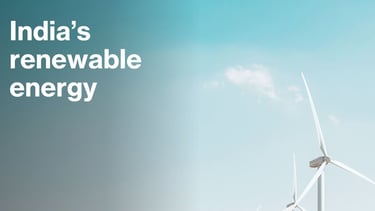How India’s renewable energy drive can shape a sustainable tomorrow?
Curious about how India’s renewable energy push is shaping a sustainable future? Read the full blog to explore how the country’s bold initiatives, policies, and innovations are transforming the energy landscape and driving a cleaner, greener tomorrow!
ENERGY AND POWER
2/25/20254 min read


India, the world’s third-largest renewable energy producer, is on a mission to transform its energy landscape. With a commitment to achieve 500 GW of renewable energy capacity by 2030 and net-zero emissions by 2070, the country is paving the way for a sustainable future. Renewable energy sources already account for over 46.3% of India’s total energy capacity, marking a significant shift toward cleaner energy.
But why does this matter? The transition to renewable energy is not just about reducing carbon emissions—it’s about ensuring energy security, creating jobs, and driving economic growth. As climate change intensifies, India’s renewable energy initiatives are proving to be a game-changer, both domestically and globally.
In this blog, we’ll explore how India’s renewable energy drive is shaping a sustainable tomorrow, from its current achievements to future opportunities and challenges.
India’s Renewable Energy Landscape: Current Status and Growth
India has made remarkable progress in renewable energy, with a total installed capacity of 203.18 GW as of October 2024. This accounts for over 46.3% of the country’s total energy capacity, making India a global leader in clean energy adoption.
Key Highlights:
Solar Power Dominance: Solar energy leads the charge with 92.12 GW of installed capacity, thanks to projects like the Bhadla Solar Park in Rajasthan, one of the largest solar parks in the world.
Wind Energy: Wind power contributes 47.72 GW, with states like Gujarat and Tamil Nadu leading the way.
Hydropower and Bioenergy: Large and small hydropower projects add 52 GW, while biopower contributes 11.32 GW to the energy mix.
India’s renewable energy sector has grown by 13.5% in just one year, reflecting the nation’s commitment to clean energy. With initiatives like the National Solar Mission and the International Solar Alliance, India is not just meeting its energy needs but also setting an example for the world.
India’s Renewable Energy Targets and Policies
India’s renewable energy ambitions are backed by robust policies and international commitments. The country has pledged to:
Achieve 500 GW of non-fossil fuel-based energy capacity by 2030.
Fulfill 50% of its energy requirements through renewables by 2030.
Reduce the carbon intensity of its economy by 45% by 2030.
Key Policies and Initiatives:
National Green Hydrogen Mission: Aims to position India as a global hub for green hydrogen production.
Production Linked Incentive (PLI) Scheme: Boosts domestic manufacturing of solar PV modules.
Green Bonds: Mobilize funds for renewable energy projects.
Public-private partnerships (PPPs) are also playing a crucial role in scaling up renewable energy projects, combining government support with private sector efficiency.
Key Drivers of Renewable Energy Growth in India
India’s renewable energy boom is driven by a combination of economic, environmental, social, and technological factors:
Economic Factors:
Declining costs of solar and wind energy technologies.
Increased investments in clean energy projects.
Environmental Factors:
Reducing carbon emissions and combating air pollution.
Mitigating the impacts of climate change.
Social Factors:
Growing public awareness of climate change and sustainable living.
Government campaigns promoting renewable energy adoption.
Technological Advancements:
Innovations in energy storage, smart grids, and AI-driven energy management.
Emerging technologies like green hydrogen and decentralized energy systems.
Challenges in India’s Renewable Energy Journey
Despite its progress, India’s renewable energy sector faces several challenges:
Land Acquisition: Complex procedures and unclear land records delay projects.
Grid Integration: The intermittent nature of solar and wind energy requires robust grid infrastructure and energy storage solutions.
Financing: Meeting the 2030 targets requires annual investments of $120–140 billion.
Policy Implementation: Bureaucratic hurdles and regulatory delays slow down project execution.
Addressing these challenges will be critical to achieving India’s renewable energy goals.
Opportunities for a Sustainable Future
India’s renewable energy sector is not just about clean energy—it’s a catalyst for job creation, rural development, and technological innovation.
Job Creation: The sector employed 1.02 million people in 2023, with potential for further growth.
Rural Electrification: Distributed Renewable Energy (DRE) solutions, like solar mini-grids, are bringing electricity to remote areas.
Green Tech Innovation: India’s green tech market is projected to reach $45–55 billion by 2027, driven by advancements in IoT, AI, and energy storage.
Export Potential: India is transitioning from a net importer to a net exporter of solar PV modules, with exports reaching $2 billion in FY 2024.
India’s Renewable Energy Success Stories
India’s renewable energy journey is marked by successful projects and innovative startups:
Bhadla Solar Park: With a capacity of 2,245 MW, it’s one of the largest solar parks in the world.
Gujarat Wind Farms: Home to some of Asia’s largest wind farms, contributing significantly to India’s wind energy capacity.
Cleantech Startups: Companies like Greenko Group and innovative startups are driving green tech innovation across the country.
The Road Ahead: What’s Next for India?
India’s renewable energy future looks promising, with several trends shaping the sector:
Green Hydrogen: The National Hydrogen Mission aims to produce 5 million metric tonnes of green hydrogen annually by 2030.
Decentralized Energy Systems: Solar-powered microgrids are expanding energy access in rural and off-grid areas.
Public Awareness and Participation: Community-led initiatives and public awareness campaigns are crucial for widespread adoption.
India’s renewable energy drive is more than just a transition to clean energy—it’s a blueprint for a sustainable future. By addressing challenges and leveraging opportunities, India is poised to become a global leader in renewable energy.
